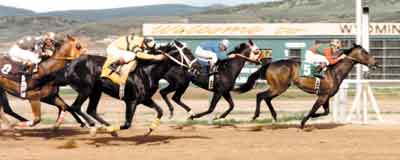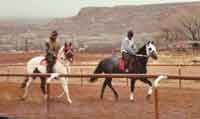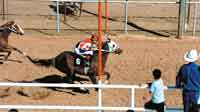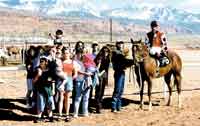PET HAPPENINGS - April 2001
And They’re Off! It’s Time For
Horse Racing In Moab
by Carol N. Wells
 When
I spoke with Chuck Henderson about horses and horse racing, I came
to realize just how much there is to know about this vital and popular
sport. We talked for about an hour, and when we were done, I felt
like I had only scratched the surface.
When
I spoke with Chuck Henderson about horses and horse racing, I came
to realize just how much there is to know about this vital and popular
sport. We talked for about an hour, and when we were done, I felt
like I had only scratched the surface.
Chuck grew up around horses and got his enthusiasm for horse racing
from his father. In 1977, he ventured into the world of horse racing
and now has seven of his own race horses.
So what breeds of horses will you find at the tracks?
Mainly quarter horses, thoroughbreds, and Arabians; though some
paints and a few Apaloosas are coming into the races as well. Many
of the paint horses are usually quarter horses that have too much
white in them to register as a quarter horse, and even though paints
and Apaloosas are slower breeds, many of the paints are being bred
with more quarter horse in them to enhance their speeds.
Quarter horses are the speedsters of the equine racing world. Quarter
horses, paints and Appaloosas are used in the short distance races,
the 200 - 440 yard races; while thoroughbreds and Arabians are the
long distance/endurance race horses and run in the 1/2 mile to 2
mile races.
“What do you look for in a race horse?” I asked Chuck.
“Mainly conformation within the breed and the pedigree. You
buy yearlings based on the pedigree, and hope they’re going
to be fast,” says Chuck with a smile.
 What
is the average career span of a race horse? As with any athlete,
sports is not a lifetime career. Quarter horses and thoroughbreds
begin racing at 2 years of age. Some horses can go as long as 14
years old, but that’s rare. Most horses no longer race after
9 years. As with any high impact sports, accidents do happen, and
some horses only get in one race, and they’re done do to injuries.
Usually, if you can get 5 to 6 years of racing out of one horse,
it’s doing well.
What
is the average career span of a race horse? As with any athlete,
sports is not a lifetime career. Quarter horses and thoroughbreds
begin racing at 2 years of age. Some horses can go as long as 14
years old, but that’s rare. Most horses no longer race after
9 years. As with any high impact sports, accidents do happen, and
some horses only get in one race, and they’re done do to injuries.
Usually, if you can get 5 to 6 years of racing out of one horse,
it’s doing well.
In talking with Chuck about racing and injuries, he pointed out
that, “You’ve got to remember that there are about 2500
pounds of body force coming down on one hoof, since horses only
have one hoof on the ground at a time when they run. So, you’re
biggest problems are going to be joint related. It’s a high
impact sport, but all the horses receive the best quality treatment;
everything from top notch veterinary care to training to food and
everything else that goes along with that. Some horses even come
back to the track after surgery.”
Chuck went on to tell me that horse racing here as anywhere else,
is highly regulated. Everyone has to be finger printed and licensed
by the state if they have anything to do with horses at a race track,
and that includes the stable help. After each race, the winner and
usually the second place horse are taken in for drug testing.
 So
where do the horses end up if they’re not going to race anymore?
Most of the mares, as well as the few stallions that race, only
race for a few years anyway, since they are valuable breeding stock,
and face quite the pampered life-style as such. Geldings make excellent
riding, roping or barrel horses as well as Polo, and hunter/jumpers,
and are usually sold for those purposes.
So
where do the horses end up if they’re not going to race anymore?
Most of the mares, as well as the few stallions that race, only
race for a few years anyway, since they are valuable breeding stock,
and face quite the pampered life-style as such. Geldings make excellent
riding, roping or barrel horses as well as Polo, and hunter/jumpers,
and are usually sold for those purposes.
Since there is no gambling in Utah, where does the purse money come
from? Entry fees from owners will be the main source, then from
sponsors and advertising money.
The money made on quarter horse racing is in the 2 year old racers.
After 3 years old, the purse money comes down; which is just the
opposite scenario as far as thoroughbreds are concerned. There is
more purse money for 3 year old thoroughbred races, and there is
bigger purse money at older ages.
The horse races at the Equestrian Center in Moab, mostly bring in
local contestants, but some of the horses come in from north and
southwest Utah, and some are from Colorado.
“The Moab Equestrian Center is a great starting point to see
what kind of racing stock you have, which then allows you to know
where to enter each horse at bigger tracks,” says Chuck.
There are different levels to enter a horse into at the track. The
Maiden Race for instance, is a race where either it’s a horse’s
first race or the horses in this race have been here before, but
have never won. The better racers from the Maiden race go on to
an Allowance race in which the purse money is higher, but then,
so is the competition. The winners from a Maiden race can go on
to either an Allowance or Claiming race.
The Claiming race includes horses that are worth anywhere from $2000
to $50,000 and up. But when you enter your horse in a Claiming race,
you have to be ready to lose that horse to a buyer. Basically what
happens in a Claiming race is that there is what is known as a “track
account” where money is deposited to buy horses. Licensed trainers
and owners can fill out a card to buy a particular horse up to 10
minutes before the race. After the race, the horse will belong to
whichever owner or trainer filled out a card for the horse, whether
it won or broke down, and the original owner no longer owns the
horse.
The Claiming race keeps horses in their own class, and breeding
stock is kept at the Allowance race level. Most race horse owners
rotate their stock by getting their horses to the highest level
of racing and then selling them.
In a “Stakes” race, the owner has to nominate his horse
and be qualified, which doesn’t always guarantee that the horse
will be entered in a Stakes race. Utah mainly holds Open and Allowance
races.
One of my curiosities was how much and what kind of training does
a race horse require?
“For a yearling, it takes 5 to 6 months to be broken to ride
to the time they are able to race,” says Chuck. “Part
of the training is a lot of slow work. Walking them along with a
pony horse to train them to relax. As they mature, they relax naturally.
The more relaxed you can keep a horse on the race track, the better
they run. If they’re too high strung, they don’t run well.
The horses will usually show you what level they’re at. Older
horse take 90 to 100 days of building up their strength and endurance
levels to get up to running on a track. Along with physical fitness
is mental fitness. Mainly, you don’t want a bored horse, which
comes from too much confinement and not enough exercise. Usually
you race a horse for about 8 months and then let them have the winter
off. It’s good for the horses to have some time off away from
the track. But then it takes a good portion of the winter to get
them ready for racing again. It’s like any other athlete in
training, you can’t just quit, do nothing, and jump into the
sport again. Every athlete trains before competing in their sport,”
explained Chuck.
 I
asked Chuck who decides which jockeys ride which horses. “Big
tracks have jockey agents that contact trainers. Usually there’s
a group of jockeys that ride the small circuits like St. George,
Roosevelt, Moab, Salt Lake. Trainers can request jockeys if they’re
not already committed to another horse. Most of the time you just
get who you get,” replied Chuck.
I
asked Chuck who decides which jockeys ride which horses. “Big
tracks have jockey agents that contact trainers. Usually there’s
a group of jockeys that ride the small circuits like St. George,
Roosevelt, Moab, Salt Lake. Trainers can request jockeys if they’re
not already committed to another horse. Most of the time you just
get who you get,” replied Chuck.
And what do the jockeys get? “They get a flat fee to ride and
if the horse they’re riding wins, they get 10% of the purse
money.”
I also wanted to know where some of these unusual names come from,
but I’m still not sure of what the originating source for the
colorful name of a race horse might be. The name’s are combined
from part of the sire’s name and part of the dam’s name.
One of Chuck’s horse’s is called Quick Down Dash, the
sire to which, was Royal Quick Dash. Sometimes a trainer will give
a nick name based on a horse’s actions or personality traits,
though Chuck wouldn’t divulge some of his horse’s nick
names. For Chuck’s thoroughbred named Courageous Fox, the sire
was named Courageous Leader, and Chuck found her to be rather foxy
looking, so hence the name, Courageous Fox.
All in all horse racing is an exciting event. Chuck made special
mention of the fact that the horsemen in Grand county are getting
better backing from the community and would like to thank the community
for their backing and support. “There’s a lot of local
talent out there, horsemen available for conditioning and training
that work very hard. We also have more facilities for boarding that
are better equipped than in the past, that are available as well,”
says Chuck.
The managers at the Equestrian Center are finally able to upgrade
and maintain the facility and numbers for events are increasing
every year. More people are coming in that are staying several months
to train in Moab, and the Equestrian Center is becoming a multipurpose
facility, which only means more revenue coming into Moab besides
just our tourist dollars.
We’ll be looking forward to enjoying the races this year. Remember,
the admission is free, so there’s no reason not to come out
and enjoy this event. A special thank you to Chuck Henderson for
sharing his knowledge on horse racing, and I’ll be looking
for Quick Down Dash and Courageous Fox. See you at the track!
© 2001 Moab Happenings.
All rights reserved. Reproduction of information contained in this
site is expressly prohibited.